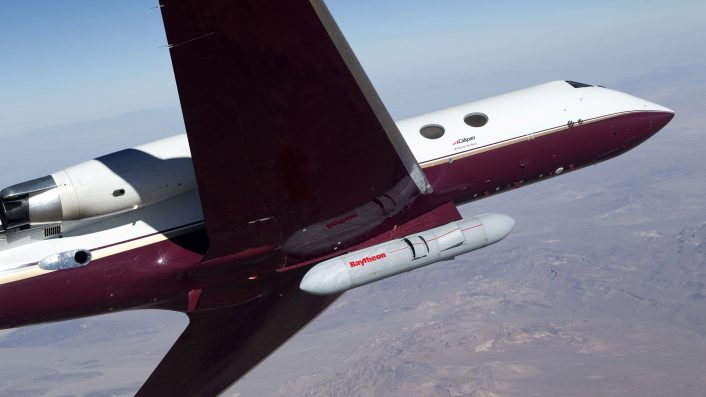NGJ-MB will replace one of the AN/ALQ-99 pods on U.S. Navy Growler Electronic Attack aircraft.
The first Next Generation Jammer Mid-Band pod Raytheon delivered to the U.S. Navy last August has been mounted on an EA-18G Growler of the Air Test and Evaluation Squadron (VX) 23 Growler at Naval Air Station Patuxent River, Maryland.
Both the U.S. Navy and Raytheon, manufacturer of the pod, have released images showing the NGJ-MB under the left wing of the Electronic Attack aircraft recently.
The pod is an Engineering and Manufacturing Development (EMD) pod, a test article used to perform ground and aircraft integration testing, delivered to the U.S. Navy this summer. Raytheon will deliver 15 EMD pods for mission systems testing and qualification as well as 14 aeromechanical pods for airworthiness certification: following the initial verification of ground procedures, installation, and Built In Test checks the pod will undergo chamber and flight testing.
NGJ-MB is a high-capacity and power airborne electronic attack weapon system designed for the EA-18G electronic attack aircraft that was designed to carry out the usual job of denying, degrading and disrupting threat radars and communication devices, from an extended range and with enhanced ability than the previous AN/ALQ-99 tactical jamming pods, developed for the EA-6B Prowler (a type that has been completely retired from active service in March this year).
According to Raytheon:
Raytheon’s NGJ-MB architecture and design include the ability to operate at a significantly enhanced range, attack multiple targets simultaneously and advanced jamming techniques. The technology can also be scaled to other missions and platforms.
As for the future, NGJ MB’s open systems architecture allows the system’s hardware and software to be upgraded quickly. A flexible design is crucial to match and defeat evolving sensing and jamming technologies in the electromagnetic spectrum. It can also house other offensive and defensive technologies to keep pilots safe.
Additionally, field modification kits can enable a variety of missions for NGJ, including communications and information operations. It could also be used on other tactical and wide-body platforms, according to Stefan Baur, vice president of Raytheon Electronic Warfare Systems.
The NGJ-MB, also known as the AN/ALQ-249(V)1 pod, uses directional emitters and AESA (active electronically scanned array) technology and an all-digital back end. It also has digital and software-based tech embedded in the design, which increases the ability to jam and allows for rapid beam steering and advanced jammer modulation. As the images show, the pod is pretty large. Its size (and subsequent induced drag – with an impact on the overall range of the Growler) was, according to GAO, the reason why the Navy rejected Raytheon’s bid for the low-band pod. This article by our friend Tyler Rogoway at The War Zone provides many details about the NGJ pods and their recent developments.

Therefore, the Raytheon NGJ-MB will replace one of high-band ALQ-99 pods that Growlers carry under each wing: another pod, dubbed NGJ-LB, will replace the low-band pod that the aircraft carry on the centerline store position under the fuselage; another one, a high-band pod, will be carried on the other wing.

While the NGJ-MB pod will “cover the majority of critical threats”, NGJ-LB will be extremely important to provide cover to stealth aircraft, threatened by the emerging counter-stealth Low Band radars, engaging enemy threats from increased stand-off distances and employing increased capacity (number of jamming assignments). Here what I explained in this past article about the F-35 and the low-band radars:
In fact, tactical fighter-sized stealth aircraft are built to defeat radar operating at specific frequencies; usually high-frequency bands as C, X, Ku and S band where the radar accuracy is higher (in fact, the higher the frequency, the better is the accuracy of the radar system).
However, once the frequency wavelength exceeds a certain threshold and causes a resonant effect, LO aircraft become increasingly detectable. For instance, ATC radars, that operate at lower-frequency bands are theoretically able to detect a tactical fighter-sized stealth plane whose shape features parts that can cause resonance. Radars that operate at bands below 300 MHz (lower UHF, VHF and HF radars), such as the so-called Over The Horizon (OTH) radars, are believed to be particularly dangerous for stealth planes: although they are not much accurate (because lower frequency implies very large antenna and lower angle accuracy and angle resolution) they can spot stealth planes and be used to guide fighters equipped with IRST towards the direction the LO planes might be.
Interestingly, the NGJ-MB does not use the typical front propeller to drive ram-air turbine: it is equipped with two pairs of doors, on each side of the pod that allow air inside the pod to power the pod.
Structural and actuation challenges will be areas to watch out for given @Raytheon unique design of the AN/ALQ-249 Next Generation Jammer (NGJ) that allows ram air to enter and exit through two sets of doors that pop open while emitting. pic.twitter.com/QeVAgEywq0
— Air Power (@MIL_STD) March 11, 2018
Noteworthy, a Prime Power Generation Capability pod installed on a Gulfstream G-III aircraft, registration N710CF, operated by Calspan, a company that provides Airborne Testbed Services, was already used to conduct power generation flight testing and risk reduction efforts in support of the initial flight clearance process.

The (few) shots you can find online give an idea of the size of the (prototype) of the AN/ALQ-249(V)1.
While waiting for the new tools to be delivered (in the next few years), the Boeing EA-18G Growler, an Electronic Warfare variant of the two-seat F/A-18F Super Hornet that replaced the EA-6B Prowlers in U.S. Navy service, continues to operate in the Middle East. As already reported, the aircraft has been deployed to Saudi Arabia recently in response to the attack to the Saudi Aramco oil fields, but it has also had an extensive anti-Daesh experience, supporting Operation Inherent Resolve against Islamic State in Iraq and Syria by actively jamming enemy communications (including cell phones) and targeting threats as well as other High Value Targets.









